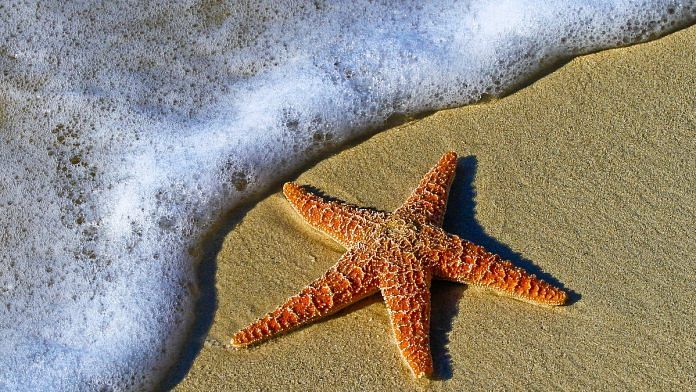What has a diameter of around one metre and is being grown in a lab by scientists hoping to reverse ecological damage in the Pacific?
The answer – sunflower sea stars.
From Alaska to Mexico, this enormous invertebrate was once a common sight on the seabed. But between 2013 and 2017, an estimated 91% of the sunflower sea star population was wiped out. It is now an endangered species.
The cause of this catastrophic decline is referred to as sea star wasting syndrome and is thought to have killed as many as 5.75 billion of the creatures.
Their disappearance has had damaging consequences for the marine ecosystem. Sunflower sea stars feed on sea urchins. Sea urchins feed on kelp. Without the presence of sunflower sea stars, their key predator in the food chain, sea urchin populations have boomed. That has led to the demise of kelp forests – which in turn contributes to the climate crisis, as kelp is an effective carbon sequester.
Breeding a solution
Scientists at the University of Washington have been working with the Nature Conservancy, a US-based environmental organization, to do something about that. At their laboratory on San Juan Island, they have been breeding sunflower sea stars that can be used to repopulate coastal waters. At least, that’s the hope.
“What we’re attempting to do here is to raise a new generation of sea stars in the lab,” Jason Hodin, a research scientist at the University of Washington’s Friday Harbor Labs, told the university’s news site: “We’re hoping that our efforts can help in the process of recovery of the sunflower sea star and, ultimately, recovery of the health of ecosystems like the kelp forests that are under threat right now.”
Rising temperatures
One of the factors likely to have led to the death of so many of the sea stars is rising ocean temperatures. The ocean absorbs most of the excess atmospheric heat caused by greenhouse gas emissions. That has the effect of increasing the temperature of the water. Many sea creatures can only tolerate very small changes to their environment.
Every decade over the past 100 years, the average global sea surface temperature has gone up by approximately 0.13C, according to data from the US National Oceanic and Atmospheric Administration (NOAA). Having been affected by changing environmental conditions in the past, including rising temperatures, how will the sea stars cope if they are released into the Pacific?
That’s one of the questions the scientists have been working on.
To test their capacity to withstand warming seas, these tiny creatures are being subjected to fluctuations in water temperatures in the lab. Some of the young adult sea stars are being raised in water that is marginally warmer than normal, and are showing signs of being able to cope with the added warmth.
“These are not typical ocean temperatures around here, and yet their apparent success indicates that the larvae at least are robust to temperature increases expected with climate change,” said Hodin.
This article was originally published in the World Economic Forum.
Also read: Climate change is set to become worst crisis of our time. Covid recovery could change that



